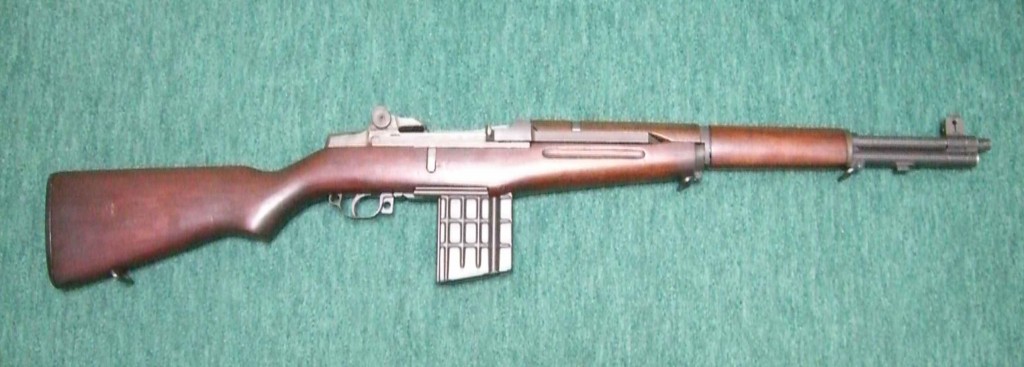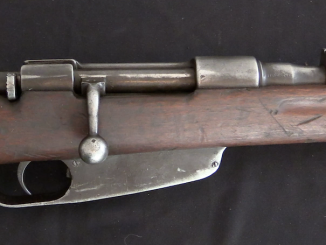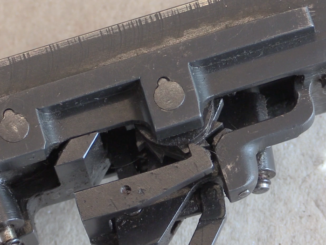In the late 1950s and early 1960s, the Dutch government was looking to adopt a new rifle for its Army, and considered both the AR-10 (which was being produced domestically by Artillerie Inrichtingen) and the FAL. The FAL won out, but it was not immediately clear if that rifle would replace everything in Dutch service, or just the front-line Army rifles. The NATRES (basically the Dutch national guard) was equipped with a great many M1 Garand rifles supplied by the US, and these was some thought as to whether it would be more cost-effective to modernize those guns rather than replace them all with new FALs.
With this in mind, two AI engineers headed to Italy to visit the Beretta company and investigate the possibility of a BM-59-type upgrade to use detachable magazines in the Garands. Being from AI, the magazine they had in mind was the aluminum AR-10 “waffle” magazine, and a couple prototypes were made using this magazine in a converted M1 Garand:

Note that the typical paddle magazine release of the M14 and BM59 was replaced by a push-button release inset into the stock, to accommodate the magazine catch on the AR-10 magazine. The guns, of course, were also rechambered to the 7.62mm NATO cartridge instead of the original .30-06.

Ultimately, this rifle never went beyond prototype stage, as it was determined that it would be simpler and more efficient to equip both the Army and NATRES with FAL rifles, rather than run two separate guns concurrently. Thanks to Vic for the photos!




Back in the 1960s, several surplus outlets such as Klein’s Sporting Goods advertised M1 rifles converted in a very similar manner. A common term for them was “M7” or “M7 1/2”, meaning a semi-auto “semi-clone” of the M14.
I don’t know which magazine these modded Garands used; they may have been M14 magazines, imported BM-59 or FAL magazines, or even BAR mags blocked in back for the shorter NATO round with a spacer. I used to own a Chinese made TT33 clone in 9 x 19mm that had the 7.62 x 25mm magazine set up in just this way to feed the shorter 9mm round reliably.
It looks like the barrel and forend have been shortened to roughly BM-59 length in the picture. Since the Netherlands Army was one of the first to adopt a “closed-top” APC (the DAF YP-408 8×8), it stands to reason that they’d want a shorter-barrelled rifle to arm the troops that would be riding in same.
cheers
eon
Did they use the same chamber insert as the BM-59?
I thought it looked a little too short, but I wasn’t sure if it was the rifle or just something with the picture. Looks like it would have been significantly handier than the full length M1.
I think it’s about midway in length between the stock M1 and the so-called “Tanker” Garand. Which would make it almost exactly the length of the original fixed-stock BM-59, minus the fixed grenade launcher spigot so many of them were fitted with. (Similar to that on the French MAS 49/56.)
Definitely handier than the regular Garand, the standard M14, or any FAL except the short-barreled Para version, actually.
cheers
eon
In any case this modified M1 is probably better than the original in urban or room-to-room firefights, where snapshots and suppressing fire is more prevalent than aimed shots at the other team. The reduced length also does make it easier to carry while riding in a vehicle, armored or not.
Had this M1 been equipped with a low-magnification fixed-power scope like the Type 97 Sniper Rifle, it might have been a good weapon for a designated marksman…
Why does the aluminum waffle mag sit further forward than the original M1 floorplate, especially since .308 is shorter than .30-06?
It’s located exactly where the magazine well on the BM59 and M14 are. I suspect the major reason is that by moving the point at which the bolt contacts the top round in the magazine forward about 1/2″, it gives better feeding and reduces the chance of a round being “tipped” upward and flipped out instead of feeding smoothly into the chamber.
This is due to the 7.62 NATO round being significantly shorter overall than the .30-06;
7.62 x 51mm NATO; Case OAL 2.01 in.
.30-06 (7.62 x 63mm); Case OAL 2.49 in.
Plus, moving it forward allows the use of a charger guide on the front of the rear receiver bridge. Both M14 and BM-59 have such a guide, to allow the refilling of the box magazine “in place” from five or ten-round chargers or “stripper clips”.
If this one had reached production, it probably would have had such a charger guide as well.
cheers
eon
A really interesting modification — is there any additional information on how reliable the conversion turned out to be versus the BM-59 and other variations? I would guess that if it was anything on the level of the BM-59 — which was, and is, a truly under-rated and largely “forgotten weapon” in the general firearms world — it would have had serious potential as a battle rifle.
Not completely forgotten–Shuffs Parkerizing is doing BM-59 conversions of M1’s these days using M14 magazines. But yes, very much under appreciated.
It would be fun to see Ian and Karl use one in a match against a more modern rifle.
Thanks very much for the information , Jacob. I will have to look into the Shuffs offering you mentioned. Great suggestion about Ian and Karl trying one out, presumably on Full30 / InRange TV.
The conversion of the barrel was similar to the Tipo 2 (Type 2) conversion of original .30″ ’06 M1 Garand barrels by the Italians to 7.62 mm chambering by turning back the barrel/chamber shoulder 1/2 an inch.
I have some additional photographs of the action ‘out of the stock’ which shows some better details of the conversion. Interestingly the two AI engineers were (I am reliably informed) regular ordnance officers in the Dutch Army who were seconded to AI to see if the conversion of the M1 Garands the Dutch Military had already were readily convertible. They spent about 6 months at the Beretta factory in Gardone val Trompia, Italy to see how Beretta had converted the M1 to BM-59 standard. On their return it was decided for speed of design (and economy) to utilize a magazine already manufactured by AI. Of course the AR10 ‘waffle’ mag was available but it does not ‘rock’ into lock like the BM-59 (or for that matter M14) magazine so the conversion is quite different from that perspective. The decision to drop the whole project was two fold.
1. The end of AR10 production and the turn over of production to the Dutch version of the FAL. This ended also the production of AR10 magazines (remember AR10 mags were meant to be discarded when empty)!
2. When FAL production was geared up, it was reckoned that building additional FAL’s for the ‘Home Guard’ was more economical and sensible (only one rifle in the inventory to support)!
What is not common knowledge is that the M14 was also considered as a rifle to arm the ‘Home Guard’ with too!
And yes, the BM-59 is a little bit ‘Forgotten’ as it was only used by one European power (Italy) the Sudanese, Indonesians, Nigerians, and Argentinians. But it never was a high profile battle rifle. Interestingly I have been researching the BM-59 development for around 8 years and have only just started to unearth the data on the acceptance trials in Italy that led to it’s adoption! The competing designs are really interesting and somewhat unknown, hopefully Ian will showcase the rifles that I turn up on this site. I’m off to Italy in a few weeks to photograph and handle the super rare and unknown competitors… And have a little pasta, wine and some great hospitality care of Beretta!
ciao
Vic
Hi Vic,
I’m an author who has a book being published by Collector Grade Publications on the AR-10, and would very much like to learn more about your study of these Garands converted to use the AR-10 mags.
These were in great supply at the time because they were considerably cheaper to make than steel FAL or M14 magazines. They were also not made by Artillerie Inrichtingen, but by a subcontractor. Owing partly to this, they were actually manufactured for a while after AI stopped making the rifles and closed up their arms bureau completely. These were made for the Portuguese who used up and ordered tons more, and were produced without the consent of the newly-independent ArmaLite. These late production runs had blank floorplate where the “ArmaLite Patents Pending” stamp was supposed to be. There were actually at least four distinct types of production AR-10 magazines made for AI, and all are around in the U.S..
I really hope to be able to pick your brain!
Hi Joe, I would be more than happy to help if I can. I was also a contributing author to the Collector Grade Publication ‘The Black Rifle’ so have a bit in common 😉
Cheers,
Vic
Please send me the pics of the receiver out of the stock. I’ve been wanting this exact mode for years. I dont care much for the rock and lock mag style.
Hi Joe, I have tried to contact you several times in the past couple of days….
There is at least one of these Garands in the vault at the Dutch Military museum, along with allot (naturally) of neat AR10s.
It takes a bit of scheduling, and they do charge, but they are very accessible for book photography.
Interestingly NATRES units got their FALs only in the late 1970s and the 1980s. According to http://www.orbat85.nl:
“In 1985 many platoons were still equipped with outdated weapons: the M1 carbine .30 inch, the M1 Garand semi-automatic rifle and the Bren lmg .303 inch. In 1978 a beginning had been made to replace these with standard infantry weapons: the UZI submachine gun 9 mm, the FN FAL battle rifle 7.62 mm and the FN MAG gpmg 7.62 mm respectively. This however proved to be problematic as there were not enough weapons to equip the many newly formed platoons. In 1984 it was decided that only the platoons and nearly all company staffs under the Zeeland, North Brabant and Limburg Provincial Military Commands/Garrison Commands would be issued with FAL (and probably UZI). The M1 Garand (and probably the M1 carbine) remained in use until 1987, whilst the replacement of the Bren lmg, begun in 1985, probably took until 1987 or 1988 as well. According to 1985 regulations a NATRES platoon counted five pistols, fourteen submachine guns and fifteen rifles.”
I recall reading once, that it took Beretta only ~18 months to design their BM-59, vs. 18 years for Springfield to design the M 14. The above conversion might take, a few hours ?